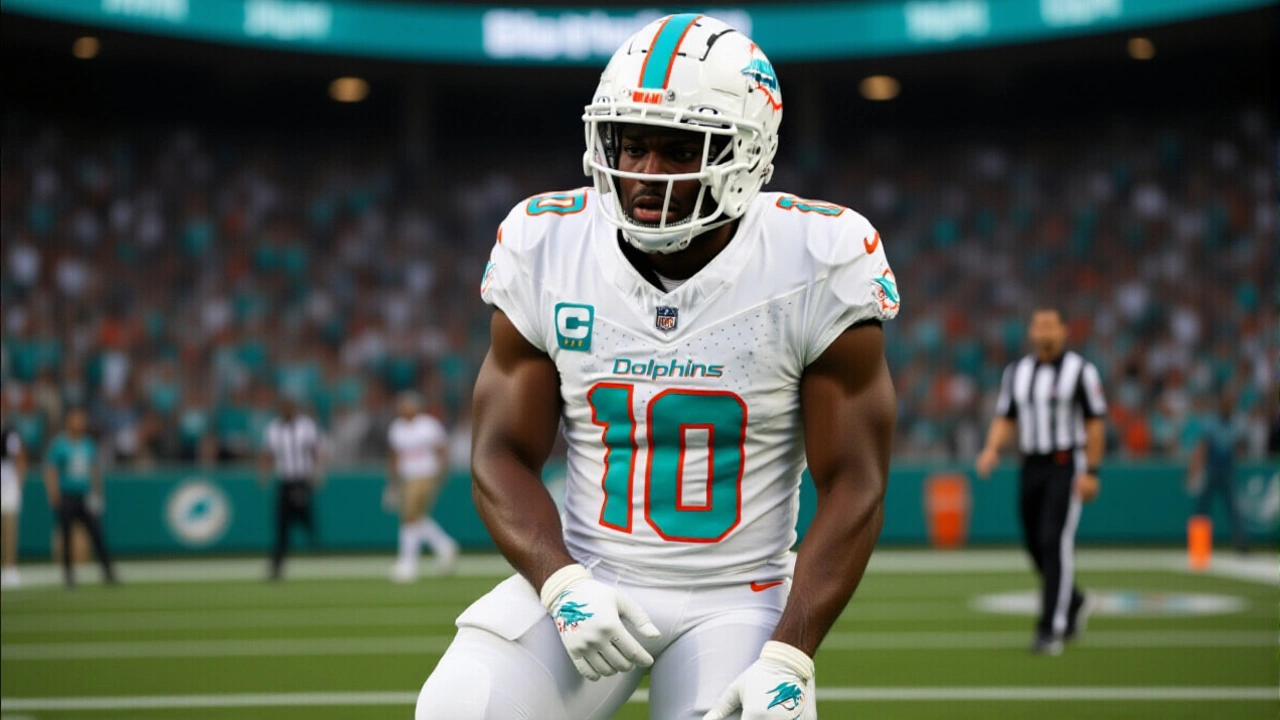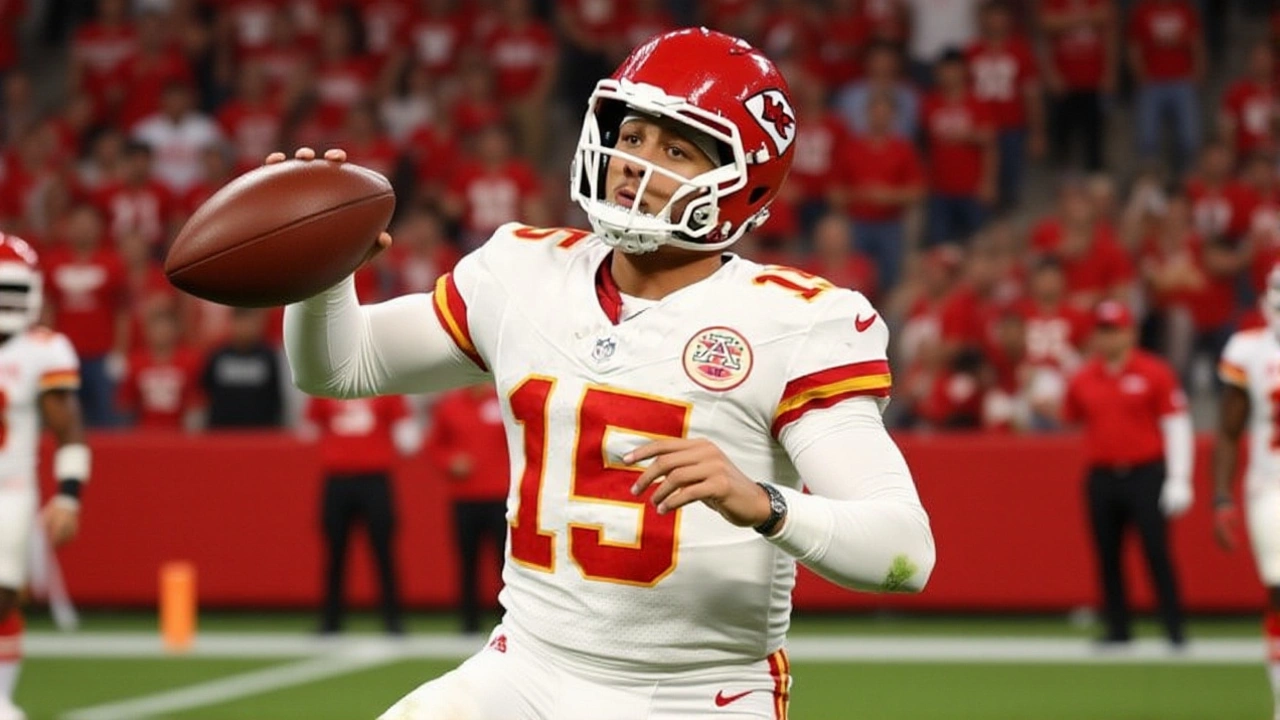Tyreek Hill's knee injury sidelines star, dims Miami playoff hopes
 Sep, 30 2025
Sep, 30 2025
When Tyreek Hill, wide receiver of the Miami Dolphins suffered a brutal knee injury during the third quarter of Monday Night FootballMetLife Stadium against the New York Jets, the arena fell silent as medics rushed him to the ambulance. The clash took place at MetLife Stadium in East Rutherford, New Jersey, on September 30, 2025, and the Dolphins held on to win 27‑24, improving to 1‑3 on the season. Doctors suspect the joint was completely dislocated, a setback that could sideline Hill for the remainder of the 2025 campaign, a loss that reshapes Miami's playoff calculations.
Background: Hill's impact on Miami's offense
Since arriving in Miami in 2022, Tyreek Hill has been the centerpiece of a fast‑paced attack built around pre‑snap motion and vertical routes. Quarterback Tua Tagovailoa has leaned on Hill’s 23‑mile‑per‑hour speed to stretch defenses, often turning a short slant into a 50‑yard gain after a quick cut. Head coach Mike McDaniel designed the system to maximize that speed, employing multiple receiver sets and frequent motion to create mismatches.
Statistically, Hill accounted for 31 percent of Miami’s total receiving yards in the first three games, hauling in 12 catches for 210 yards and two touchdowns. Even in the loss to the New England Patriots, his ability to break away on jet‑sweep plays kept the Dolphins within striking distance. When the Dolphins finally tasted victory against the Jets, Hill finished with four receptions for 112 yards, including a pivotal 45‑yard catch that set up the go‑ahead field goal.
The injury: what happened on Monday night
It was a routine slant route on third‑and‑10 when Hill broke free, slipped, and landed awkwardly on his planted foot. The stadium’s replay boards showed the moment his knee buckled inward, followed by a grotesque pop that was impossible to miss. Teammates and officials converged immediately; the medical crew’s first assessment was a possible dislocation with ligament damage. Hill was helped to a stretcher and carted off the field, later being taken to a nearby hospital for further evaluation.
Team physicians released a brief statement confirming a “significant knee injury that will require imaging and possibly surgery.” While they stopped short of an official timeline, the consensus among NFL injury analysts is that a dislocation often means months of rehab, if not a season‑ending scenario.
Immediate repercussions for the Dolphins
The loss of Hill reverberated instantly on the sideline. Miami’s play‑calling in the fourth quarter shifted to a more run‑heavy approach, leaning on veteran running back De'Von Achane and the newly signed wideout Jaylen Waddle. Both players displayed flashes of big‑play ability, yet neither matches Hill’s unique blend of speed and route‑running precision.
In the meantime, the Dolphins' tight end group saw a bump in usage. Veteran Darren Waller caught two touchdowns in the very next game, while the coaching staff experimented with two‑tight‑end formations on 14 percent of snaps – a stark contrast to zero usage in the opening three weeks.
From a morale standpoint, the locker room was visibly shaken. In post‑game interviews, McDaniel emphasized “the importance of staying focused and trusting the depth we have.” Tagovailoa, who was visibly concerned, said he hoped Hill’s recovery would be “as quick as the body allows.”

Who could step up? Depth chart analysis
With Hill on the shelf, the Dolphins now have to lean heavily on two primary weapons: Waddle and Achane. Waddle, who posted 75 yards on three catches in the Jets game, possesses a quick‑stop ability that can open up the middle of the field, but he lacks Hill’s deep‑ball threat. Achane, a former rapid‑fire running back, offers a dual‑threat as a runner and a receiver out of the backfield. His 42‑yard reception against Buffalo last month showcases his versatility.
- Jaylen Waddle – 23‑year‑old rookie with 5.6 sec 40‑yard dash; excels in yards‑after‑catch.
- De'Von Achane – 21‑year‑old former Texas A&M sprinter; can line up in the slot or stretch the field.
- Darren Waller – veteran tight end; proven red‑zone target, now getting more snap counts.
- Mike Wallace – veteran depth receiver; could fill short‑route duties.
Beyond the receivers, the offensive line will need to provide extra protection for Tagovailoa, who has been under pressure on 38 percent of dropbacks this season. A more balanced run game could also alleviate the passing burden, especially against upcoming divisional foes with stout secondary units.
What this means for Miami's playoff outlook
Before the injury, Miami was already hovering near the bottom of the AFC East at 1‑3. Losing Hill, who contributed to nearly one‑third of the team’s offensive production, pushes the Dolphins deeper into the “must‑win” zone for the rest of the year. Statisticians at Pro Football Focus note that teams without a top‑10 receiver see a 2.5‑point drop in expected points per game.
However, the setback could also serve as a catalyst for other players to emerge. If Waddle can replicate the deep‑play capability and Achane can become a reliable third‑down option, Miami might still stay competitive for a Wild Card berth. The next three games – against the Buffalo Bills, the New England Patriots, and the Indianapolis Colts – will be decisive. A healthy Tagovailoa paired with a diversified receiving corps could keep the Dolphins afloat, but the margin for error has narrowed dramatically.
From a contract perspective, Hill’s $30‑million extension signed in 2024 looms on the horizon. An extended absence could affect future negotiations, especially as the Dolphins contemplate building around a younger core. For now, the focus remains on medical clearance and adjusting the playbook around the personnel available.
Frequently Asked Questions
How severe is Tyreek Hill's knee injury?
Doctors have described the injury as a dislocation, which typically involves torn ligaments and cartilage damage. Recovery can range from three to nine months, depending on whether surgery is required, so missing the rest of the 2025 season is a strong possibility.
Who will replace Hill in the Dolphins' receiving corps?
Jaylen Waddle and De'Von Achane are the obvious next‑in‑line options. Waddle brings quick cuts and reliable hands, while Achane offers speed from the slot and the backfield. Tight end Darren Waller is also seeing a larger role in short‑yardage situations.
What does this injury mean for Miami's playoff chances?
Losing a top‑tier receiver drops Miami's expected points per game by roughly 2.5 points, according to analytics models. The Dolphins now need to win most of their remaining games and rely on a more balanced offense to stay in Wild Card contention.
When is Tyreek Hill expected to return?
The medical team has not set a definitive timetable. If conservative rehab is chosen, the earliest realistic return could be early in the 2026 season, but any 2025 comeback would depend on imaging results and progress in physical therapy.
How might the Dolphins adjust their offensive strategy without Hill?
Coach McDaniel is likely to lean more on two‑tight‑end sets, incorporate more roll‑outs for Tagovailoa, and increase the run‑pass balance. Expect quicker short passes to the slot and a heavier use of play‑action to create space for the remaining receivers.